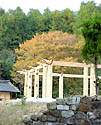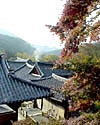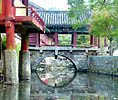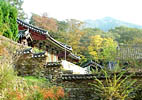  Located on the western side of Chogye-san Provincial Park, it is one of the
Sambosachal temples, along with
Haein-sa
and Tongdo-sa.
Sambosachal means the temples of three treasures.
Sambo means three treasures and sachal means temple. The three treasures consist of
bulbo (no statue of Buddha in the main sanctum), bopbo (contains Buddhist scriptures),
and seungbo (famous monks). Tongdo-sa Bulbosachal is a sarira (a
type of stone left over from the cremation of famous monks), Haein-sa
Bubosachal is the Tripitaka Koreana, and
Songgwang-sa Seungbosachal is its tradition for producing famous monks:
Songgwang-sa has produced 16 state monks during its history.
Located on the western side of Chogye-san Provincial Park, it is one of the
Sambosachal temples, along with
Haein-sa
and Tongdo-sa.
Sambosachal means the temples of three treasures.
Sambo means three treasures and sachal means temple. The three treasures consist of
bulbo (no statue of Buddha in the main sanctum), bopbo (contains Buddhist scriptures),
and seungbo (famous monks). Tongdo-sa Bulbosachal is a sarira (a
type of stone left over from the cremation of famous monks), Haein-sa
Bubosachal is the Tripitaka Koreana, and
Songgwang-sa Seungbosachal is its tradition for producing famous monks:
Songgwang-sa has produced 16 state monks during its history.
 
 
 

  Built towards the end of the Shilla Dynasty by master Hye-rin, the temple was originally named
Kilsang-sa. During the Koryo Dynasty its name changed to Songgwang-sa
(meaning "extensive pines temple"). Burned down during the Chosun dynasty, it underwent
several renovations since that time, but was heavily damaged again in 1948 and 1951. In 8
reconstruction projects from 1984 to 1988, 33 complexes have been restored. In 1969, the temple was
designated a Chogye Chong-nim (complete training center for the Chogye Buddhist order in Korea).
The doctrinal teachings, along with Son (Zen) practice and the Bodhisattva ideal of selfless
compassion, are revitalizing the Chogye and Po-jo traditions. Today, the temple is
home to many monks from overseas and is a place to study the Buddhist culture of Korea.
Built towards the end of the Shilla Dynasty by master Hye-rin, the temple was originally named
Kilsang-sa. During the Koryo Dynasty its name changed to Songgwang-sa
(meaning "extensive pines temple"). Burned down during the Chosun dynasty, it underwent
several renovations since that time, but was heavily damaged again in 1948 and 1951. In 8
reconstruction projects from 1984 to 1988, 33 complexes have been restored. In 1969, the temple was
designated a Chogye Chong-nim (complete training center for the Chogye Buddhist order in Korea).
The doctrinal teachings, along with Son (Zen) practice and the Bodhisattva ideal of selfless
compassion, are revitalizing the Chogye and Po-jo traditions. Today, the temple is
home to many monks from overseas and is a place to study the Buddhist culture of Korea.
 
 
 

  Uhwagak Pavilion
Uhwagak Pavilion
This early 18th-century structure is a unique combination of bridge, pavilion, and gate, and is
designated South Jeolla Province Tangible Cultural Asset #59. The roof is hipped and gabled in
one part and gabled in the other. The eaves are bracketed simply on the supporting pillars, and
floral plates decorate the tie beams. Paneled doors are inside the building.
Kuksa-jon
  This hall (designated National Treasure #56) houses portraits of the three monks who founded
Songwang-sa. The construction style indicates that the present
structure was built during the early Chosun period (1392-1910), around the time the Hasa-dang
dormitory was built. The front of the hall is unusually divided in four between five pillars,
and the sides have two extra pillars. Although the eaves are bracketed simply, they are quite
decorative. Part of the ceiling above the main beam is checked, but the framework behind it
suggests that it was originally intended to be an open ceiling.
This hall (designated National Treasure #56) houses portraits of the three monks who founded
Songwang-sa. The construction style indicates that the present
structure was built during the early Chosun period (1392-1910), around the time the Hasa-dang
dormitory was built. The front of the hall is unusually divided in four between five pillars,
and the sides have two extra pillars. Although the eaves are bracketed simply, they are quite
decorative. Part of the ceiling above the main beam is checked, but the framework behind it
suggests that it was originally intended to be an open ceiling.
Admission: Adults 2,500 won, Students 1,500 won
Directions: Honam Expressway -> Songgwang-sa Interchange -> turn right at Juam -> National Road #27 towards Boseong -> Juamhoban Road -> Songgwang-sa
 
 

(For more pictures and content, please see page 2.)
|














